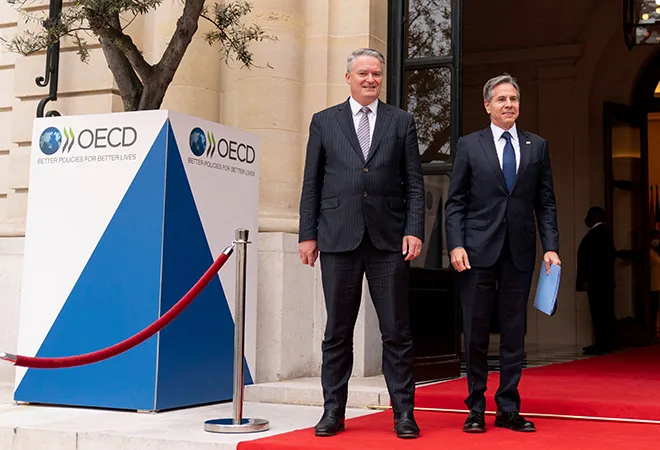
With the ever-expanding digital economy, how corporations conduct business has evolved manifolds. Today, the primary factor of production is on the cloud in the form of data rather than in physical factories. In the wake of the evolving nature of business, the international tax system has remained outdated. Attributed to which the big tech companies, mainly United States (US)-based, have been able to evade taxes. This is also called ‘Base Erosion and Profit Shifting’ (BEPS). According to a report by
Fair Tax Mark, between 2010 and 2019, multinational companies in the digital space across all offshore setups paid US$155 billion less than what the actual tax would have required them to pay. Moreover, the US digital services companies pay four times more to the US than what they pay to other countries, while their significant income is accrued from countries other than the US. Thus, the countries imposed Digital Services Tax (DST) so that the digital companies pay their fair share of tax to the countries that help them accrue their gains. However, there was no global consensus on this issue, so countries arbitrarily decided on their tax rates. For
example, Kenya imposed 1.5 percent, while some countries in Europe imposed up to 5 percent DST. Likewise, the Government of India has imposed a 2-percent levy on revenues generated by non-resident digital services providers with a turnover of over INR2 crore in India, expanding the scope of the equalisation levy, which till 2020, only applied to digital advertising services. The new law, introduced in the Union Budget, came into effect on 1 April, 2021.
The US digital services companies pay four times more to the US than what they pay to other countries, while their significant income is accrued from countries other than the US.
The US retaliation
In a counter move against DST, the US imposed retaliatory tariffs of up to 25 percent on some products in several countries, including India. The United States Trade Representative (USTR)
investigation report on India regarding the law, argues that it is discriminatory on many grounds. First, the law exempts Indian companies while targeting non-Indian firms, burdening them with double taxation. The second issue of contention is that DST contravenes the international tax convention as it is imposed on companies without a physical presence in India. Moreover, USTR argues that 119 companies are likely liable under the DST, 86(72 percent) of which are US companies making DST essentially discriminatory against the US. However, all these arguments disregard the rationale for introducing DST. The DST aims to ensure that non-resident digital service providers pay their fair share of tax on revenues that they generate in the Indian digital market. The tax becomes even more relevant during the pandemic when these tech giants have boomed and increased their business through big markets like India. This tax is essential for developing economies to cope with the crisis at hand.
To resolve the global debate around digital taxes, the Organisation for Economic Co-operation and Development (OECD) stepped up to develop a model to tax digital services companies uniformly around the globe. The tax mechanism serves the dispute around digital taxation in
two pillars. Pillar one says that multinational companies with global sales of over 20 billion euros and profitability of 10 percent will have to pay taxes on where they conduct business irrespective of their home market. And the second pillar suggests a global minimum tax rate of 15 percent, irrespective of where they set their home base.
The DST aims to ensure that non-resident digital service providers pay their fair share of tax on revenues that they generate in the Indian digital market.
A way forward
India, however, had pitched for
1 billion euros threshold which would have covered 5,000 global entities vis-á-vis. the new deal which would cover only the top 100 digital MNEs. India’s DST collection
increased 90 percent to reach INR4,000 crores owing to the post-pandemic economic recovery, increased tax scope and improved compliance. It is anticipated that the digital tax revenue might decrease as a result of the OECD tax deal. Despite this, India ratified the deal as the G20 grouping played a major role in building political consensus on this matter amongst the non-OECD members due to the membership overlap between OECD and G20 countries.To circumvent the reduction in tax revenues, India must push for the UN Model Tax Convention.
Article 12B of the UN Tax Model lays down the principle that the beneficial owner of that income is a resident of the other contracting state, and the amount of tax imposed by the state of source may not exceed a maximum percentage of the gross amount of the payment as may be negotiated between the two parties. Given India’s limited partners in digitally-enabled services– the US, China, and a few of the European countries, deciding on a bilateral percentage should not be a problem. However, the OECD tax deal does not provide this flexibility as it has indicated a minimum tax rate of 15 percent, going anywhere above that will be difficult to negotiate. Additionally, the UN model contemplates taxation of ‘qualified profits’ which is 30 percent of the amount resulting from applying the beneficial owner’s profitability ratio or the profitability ratio of its automated digital business segment, if available, to the gross annual revenue from automated digital services derived from the contracting state where such income arises. This clause brings all the technology companies, big or small, in the tax ambit. Whilst the OECD tax deal only taxes those companies that have a minimum of 20 billion euros of global sales, excluding many medium-sized tech companies from taxation.
Unlike the OECD’s global tax deal, the UN model fares better firstly with respect to flexibility, giving source country a higher stake in deciding the tax rates with the partners, leading to a fair distribution. Secondly,
the UN model allows taxing of medium-sized firms as well. Hence, The UN model is more developing-countries-centric as it focuses more on taxing rights to the source country than on avoiding double taxation. It enables developing countries to accrue a part of the gains that their citizens help the Big Tech companies generate.
The views expressed above belong to the author(s). ORF research and analyses now available on Telegram! Click here to access our curated content — blogs, longforms and interviews.



 With the ever-expanding digital economy, how corporations conduct business has evolved manifolds. Today, the primary factor of production is on the cloud in the form of data rather than in physical factories. In the wake of the evolving nature of business, the international tax system has remained outdated. Attributed to which the big tech companies, mainly United States (US)-based, have been able to evade taxes. This is also called ‘Base Erosion and Profit Shifting’ (BEPS). According to a report by
With the ever-expanding digital economy, how corporations conduct business has evolved manifolds. Today, the primary factor of production is on the cloud in the form of data rather than in physical factories. In the wake of the evolving nature of business, the international tax system has remained outdated. Attributed to which the big tech companies, mainly United States (US)-based, have been able to evade taxes. This is also called ‘Base Erosion and Profit Shifting’ (BEPS). According to a report by  PREV
PREV


